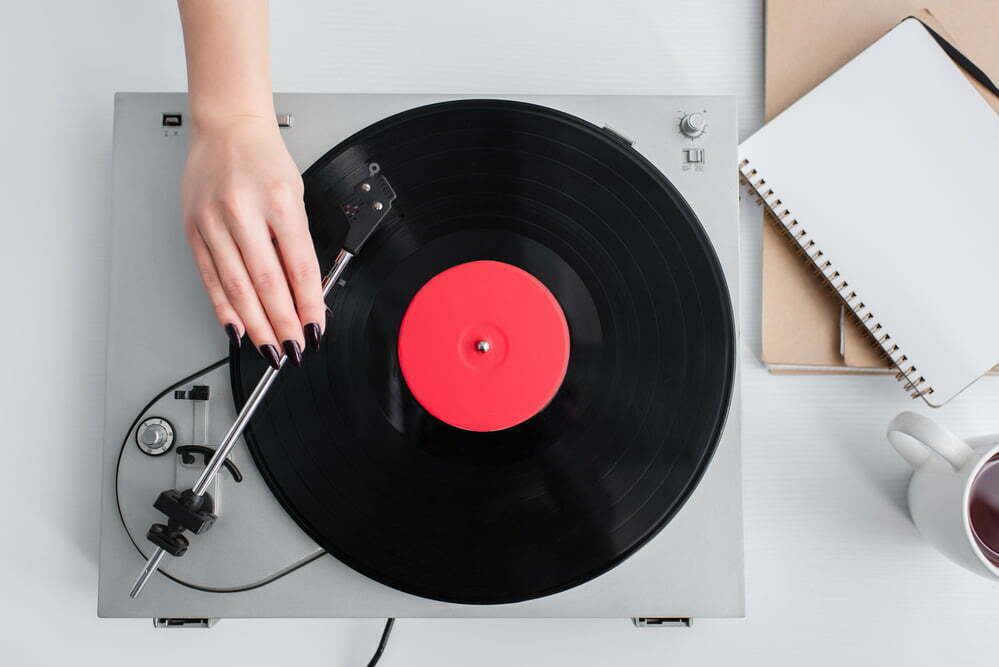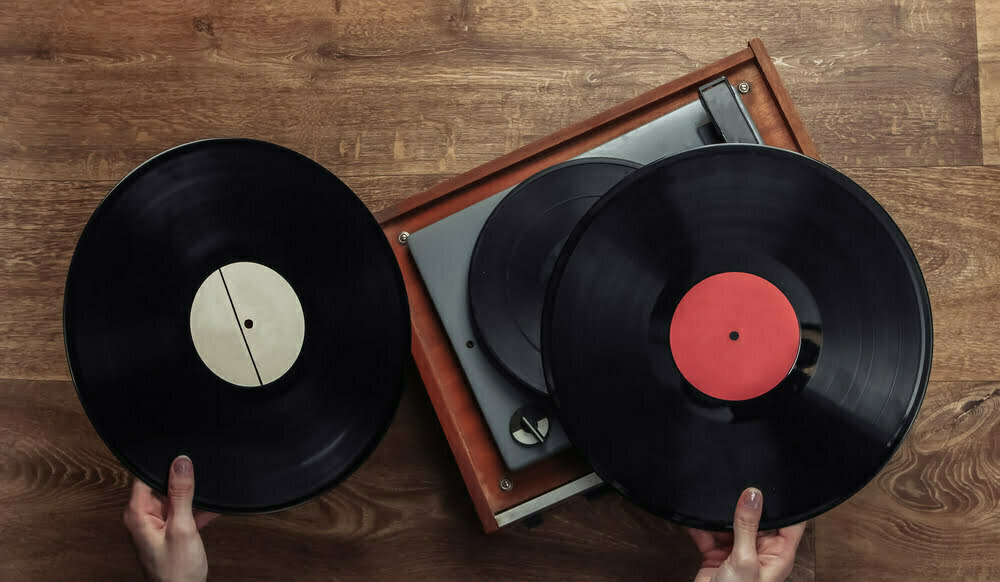On my way home from the gym one day, I passed by an antique shop, and something caught my eye.
One thing led to another, and I found myself walking out of the shop with a vinyl record player and a few records. When I got home and tried it out, I was immediately taken with the depth and quality of the way the music sounded.
This got me wondering, how do vinyl records play music?
Read on to find out more about how a rotating disc and a metal rod can combine to create such beautiful sounds.
How Do Vinyl Records Play Music?
To produce sound, vinyl records depend on engraved grooves and elevations that act as the unique “fingerprint” of the song being played.
Once the record starts spinning on the record player, the tip of the player’s stylus makes contact with it and deciphers the grooves on it.
The stylus is connected to a cartridge on the other side, which converts the stylus’ input into electrical signals and feeds them into an amplifier.

How Vinyl Records Are Made
The process of crafting a vinyl record is a long one with plenty of intricacies.
The journey starts with the mastering engineer, who optimizes the artist’s digital studio recordings to be imprinted on vinyl.
The next step is creating the master disc, which is the main vinyl disc the music will be imprinted on. This master disc is then used as a base to make many more copies of the record.
Once the master disc has been made, it’s inspected with a microscope to ensure that it isn’t defective. This is highly important because any imperfection in the master disc will be transferred to the copies.
Finally, when it’s confirmed that the master disc is good to go, the music is imprinted on it. This is done using a piece of machinery called a cutting lathe, which creates the grooves that make up the record’s sonic fingerprint.
Must Read: What Do You Play Vinyl Records On?
How Do Vinyl Records Work? A Deeper Dive
The mechanism by which vinyl records play music is a rather complicated one. However, we’ve simplified it for you in layman’s terms.
Each component of a record player has a role in producing music from vinyl. Here’s the full process explained in detail.
1. The Record Player Spins the Disc
First off, when you place a vinyl record on a record player, the player spins it, allowing the stylus (we’ll get to that later) to access every part of the record’s surface.
The record player spins the disc at a constant speed, which is determined by the number of songs on a given side of the record, and in turn, by the width of the disc itself.
The greater the number of songs or the duration of the music recorded on the vinyl in general, the slower the record will spin.
2. The Stylus Deciphers the Code
Each vinyl record has a unique set of engraved grooves on it. These grooves are the cipher that holds the key to the music that the vinyl record has to offer.
How is this code broken? The answer is the stylus. Once the record is spinning, the record player automatically lowers the tip of the stylus onto it.
The stylus then senses the peaks and troughs on the record, reading them and transmitting the information to other components of the record player.
Users Also Read: Do vinyl records count as media mail?
3. The Messenger Plays Its Part
Next up is the tonearm, which is the metal bar that connects the stylus to another internal component of the record player called the cartridge.
The role of the tonearm is to receive input from the stylus in the form of mechanical energy (vibrations). It then relays it to the cartridge to be converted into an electrical signal.
4. The Cartridge Works Its Magic (Or Science)
The cartridge converts the mechanical energy relayed to it by the tonearm into electrical energy using an electromagnet (a magnet surrounded by a metal coil).
It then turns this electrical energy into impulses, which are transmitted to the amplifier for the final step of the journey from vinyl to sweet music.
5. The Amplifier Makes the Dream Work
The final phase of the process is carried out by the amplifier, which makes sense of the electrical impulses it receives from the cartridge. This process fulfills the ultimate goal of creating sound from the vinyl record.
The sound waves created by the amplifier cause the air around your ears to vibrate, allowing you to hear and enjoy your favorite music.

Do Vinyl Records Sound Better Than Digital Ones?
In the case of music, newer isn’t always better. Digital music formats are definitely more convenient, but what about their sound quality?
Vinyl records are widely viewed to produce the purest and highest quality sound out of any music-playing medium. This is especially true when compared to the quality of the sound produced by digital music formats and mediums.
There are several reasons why that’s the case, here are some of them.
Vinyl Records Replicate Natural Sound Exactly
One reason why the sound produced by vinyl records is so natural is that the sound of the artist is imprinted exactly as it is on the record. Digital records, on the other hand, go through editing processes that alter the sound and compromise its quality.
This is why vinyl records give you the impression that you’re listening to a live performance of the music.
Related: Why Do Vinyl Records Sound High-Pitched?
Audio on Vinyl Records Doesn’t Need to Be Compressed
When audio files are placed on digital mediums, there is the factor of storage space to be taken into consideration.
A lot of the time, audio files need to be compressed in order to be accommodated by devices such as computers and smartphones. This compromises the quality of the sound.
When it comes to vinyl records, storage space is irrelevant. Audio can be imprinted on a vinyl record without any alteration and be as long as it needs to be.

